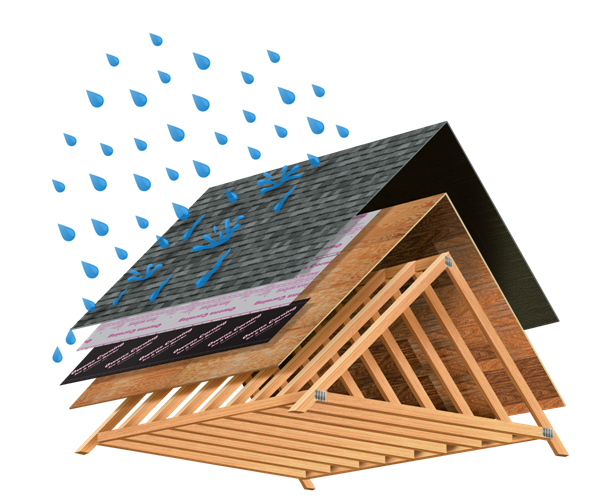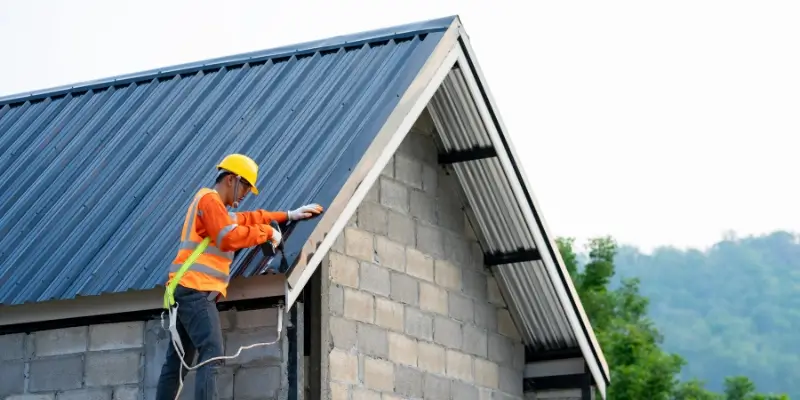A Comprehensive Guide to the Installment Refine for Your New Roof
The installment process for a new roofing system requires cautious consideration of numerous elements. From reviewing the roofing's structural honesty to selecting appropriate materials, each action plays an important duty in guaranteeing a successful outcome. Understanding the subtleties of setup can prevent future problems and boost longevity. What are the essential actions one must follow to accomplish a lasting and trusted roof covering? The response lies in an organized technique that resolves every critical element.
Understanding Different Roof Covering Materials
When selecting a roof, recognizing different roof materials is important for making a notified decision. Various products supply distinct benefits and drawbacks, influencing sturdiness, price, and visual appeals. Asphalt shingles are preferred for their price and ease of installment, making them a common option for homes. Steel roof covering, known for its durability and resistance to severe climate, attract those seeking durability. Clay and concrete tiles offer an one-of-a-kind aesthetic and outstanding insulation however can be larger and much more costly. Slate roof covering, commemorated for its all-natural appeal and extraordinary life-span, often tends to be a premium choice needing competent installation. For environmentally-conscious home owners, eco-friendly roof, which incorporate greenery, existing lasting benefits. Comprehending these products permits home owners to straighten their selection with budget, climate considerations, and personal style preferences, ultimately ensuring a roofing solution that meets their requirements efficiently.
Assessing Your Roof's Architectural Honesty

Reviewing a roof's architectural integrity is vital for ensuring its durability and security. This process entails evaluating the roof covering framework for any signs of weak point, identifying possible water damages, and figuring out the load capability to sustain different roof materials. Attending to these elements will certainly help maintain the total wellness of the roof.
Inspecting Roofing System Framework
Prior to installing a brand-new roofing system, it is critical to thoroughly check the roof framework to validate its structural honesty. This process includes reviewing crucial elements such as rafters, trusses, and the total framework layout. A certified inspector must try to find indicators of wear, warping, or any kind of structural shortages that can endanger the brand-new roof covering installation. In addition, it is necessary to look for proper load circulation, making particular that the framework can support the weight of the brand-new products. Any type of determined concerns need to be resolved before proceeding, as they can lead to substantial troubles down the line. By prioritizing this examination, property owners can guarantee a durable and dependable roof that will endure the test of time.
Determining Water Damage
Water damages can substantially impact a roofing's structural integrity, making it essential to determine any type of indications early in the inspection procedure. House owners should try to find discoloration or discolorations on ceilings and wall surfaces, which might indicate leakages. Sagging areas in the roof or ceilings recommend gathered moisture that could endanger architectural elements. Examining the attic room is essential; mold and mildew growth and damp insulation are indications of water invasion. Additionally, checking out the roofing surface for missing tiles, fractures, or rust on metal parts can expose potential susceptability to water damages. Normal evaluations can help in very early detection, enabling timely repairs that protect the roofing system's honesty and protect against considerable damages. Dealing with these signs immediately is crucial for preserving a long lasting and secure roof.
Assessing Load Ability
Examining the load capability of a roof is necessary for ensuring its architectural honesty and long life. This analysis entails taking a look at the materials used in the roofing system's construction, the underlying framework, and the overall style. Aspects such as snow build-up, wind tons, and the weight of roof covering products have to be considered to determine whether the structure can sustain added loads. An architectural designer can give useful understandings, carrying out estimations based on local building regulations and environmental conditions. Routine examinations and maintenance also play a crucial role in determining possible weak points. By extensively assessing lots capability, home owners can stop expensive damages and make particular that their brand-new roof is sturdy and secure for many years to come.
Preparation and Preparing for Installment
Efficient preparation and prep work are important steps before installing a roof - top rated roofing companies near me. This includes evaluating specific roof covering needs and picking the suitable products that best fit those demands. A detailed understanding of these aspects can substantially affect the success and long life of the roof covering task
Evaluating Your Roofing Needs
How can one guarantee that their roof covering project satisfies both practical and aesthetic demands? An extensive assessment of roofing demands is essential. This entails checking out the present roof's problem, determining any kind of damage, and identifying architectural stability. House owners must consider their climate, as climate condition see this substantially affect roof covering material options and durability. Furthermore, examining architectural design and neighborhood looks is essential for preserving residential property value and appeal. Understanding individual preferences and spending plan restraints further help in making notified decisions. Lastly, speaking with roof specialists can give valuable insights and recommendations tailored to particular needs. By carefully evaluating these variables, house owners can guarantee their roof job straightens with their special needs and enhances their building's general appearance.
Choosing the Right Materials
When selecting products for a roofing job, it is necessary to consider both capability and appearances to assure a successful setup. Homeowners must take into consideration the environment of their area, as certain materials carry out far better under certain climate conditions. For instance, steel roof coverings provide resilience in locations prone to hefty snowfall, while asphalt roof shingles may be more affordable for milder climates. In addition, the style of the home plays a significant function; products need to complement the building design to enhance aesthetic appeal. Sustainability is another aspect; eco-friendly options like solar ceramic tiles or recovered wood can minimize environmental impact. Eventually, selecting the best products entails stabilizing these components to safeguard a durable and visually enticing roof.
Safety And Security Safety Measures During Setup
Guaranteeing security throughout roof covering system installment requires careful attention to information and adherence to developed procedures. First and foremost, employees should put on proper individual safety tools (PPE), consisting of headgears, gloves, and non-slip footwear, to lessen injury threats. Scaffolding and ladders must be securely positioned and kept to provide steady job surface areas. It is necessary to inspect the roof structure for weaknesses or damages prior to starting work, as this can avoid mishaps later.
Additionally, installers ought to be trained in autumn defense strategies, including the use of guardrails and harnesses. Weather condition problems additionally play a substantial role; work needs to be held off during high winds, rain, or storms. In addition, all tools and products need to be arranged and safeguarded to avoid tripping hazards. By prioritizing these safety precautions, the danger of crashes can be significantly reduced, making certain a safer working atmosphere for all associated with the roof covering installment procedure.
Step-by-Step Setup Process
A successful roof installment entails a series of carefully prepared actions that guarantee both effectiveness and quality. At first, the old roof product must be gotten rid of, ensuring the underlying structure is intact. Next, any type of needed repair work to the roofing system deck are performed, enhancing its stability. Following this, a moisture barrier is mounted to safeguard versus water infiltration. The selection of roof covering material, such as roof shingles or metal panels, is after that set out, starting from the eaves and proceeding upwards. Each piece is safeguarded thoroughly to endure climate conditions. Ventilation systems are integrated to advertise airflow and prevent moisture buildup. Flashing is set up around chimneys and vents to further protect against leakages. Lastly, the setup is assessed for conformity with local building ordinance and manufacturer requirements. This extensive approach ensures a reliable and sturdy roof that fulfills home owner expectations.
Completing Touches and Assessments

When the installation of all components click reference is full, an extensive evaluation complies with. This includes monitoring for appropriate alignment, safe and secure fastening, and ample sealing of seams. Examiners additionally review ventilation systems to guarantee peak airflow and dampness administration.
Furthermore, any debris or leftover materials from the setup need to be removed from the roof and bordering area. By meticulously addressing these information, home owners can assure that their brand-new roofing system is not just functional yet likewise visually attractive, setting the stage for long-lasting performance and toughness.
Upkeep Tips for Your New Roofing
While lots of property owners may overlook the importance of regular roofing upkeep, establishing a routine can substantially prolong the life expectancy and performance of a new roof. Normal assessments ought to be conducted at least twice a year, preferably in springtime and autumn, to recognize any prospective concerns early. Homeowners ought to look for loose or absent tiles, important source indicators of wear, and debris build-up in seamless gutters and valleys.
Cleansing the roofing system surface area and seamless gutters is essential to avoid water damage and mold development. In addition, cutting overhanging branches can reduce deterioration triggered by falling debris. It is likewise advisable to monitor interior ceilings for indicators of leaks or water stains, which could suggest roof covering issues.
Engaging a professional for yearly inspections ensures that any kind of underlying problems are attended to immediately, protecting the stability of the roofing system and providing tranquility of mind for homeowners.

Regularly Asked Questions
For how long Does the Roof Setup Process Normally Take?
The roofing setup process usually takes one to 3 days, depending upon the task's dimension and complexity. Factors such as climate conditions and the type of roof covering material can additionally influence the overall timeline.
What Allows Are Required for Roof Covering Setup?
The required licenses for roof installment normally include structure permits, architectural permits, and, in some locations, electric or plumbing licenses. Regulations might differ based on regional codes, necessitating appointment with local authorities for certain requirements.
Can I Stay At Home Throughout the Setup?
Property owners can stay throughout roof setup, yet it might be troublesome because of noise and disturbances. Service providers suggest avoiding of workspace for safety and security and to enable the crew to execute their tasks successfully.
Will My Insurance Coverage Cover the Roofing Installation Expenses?
Insurance insurance coverage for roof covering setup costs varies based upon specific policies and conditions. Home owners must consult their insurance provider to establish eligibility for insurance coverage, consisting of factors like damage seriousness and policy terms pertaining to roof covering substitute.
What Happens if It Rains Throughout Installment?
Workers might halt development to stop damage to materials and guarantee safety if it rains during installation. Rain can also postpone conclusion, calling for extra time for drying out and potential re-evaluation of the roof covering task.
The installment process for a new roofing system requires cautious consideration of various variables. When picking a roof system, comprehending different roof covering products is necessary for making a notified decision. When picking materials for a roof covering task, it is essential to take right into account both performance and aesthetic appeals to guarantee an effective installation. Making certain safety during roofing system installment calls for thorough focus to detail and adherence to established protocols. A successful roof covering system setup involves a collection of very carefully intended actions that assure both performance and top quality.